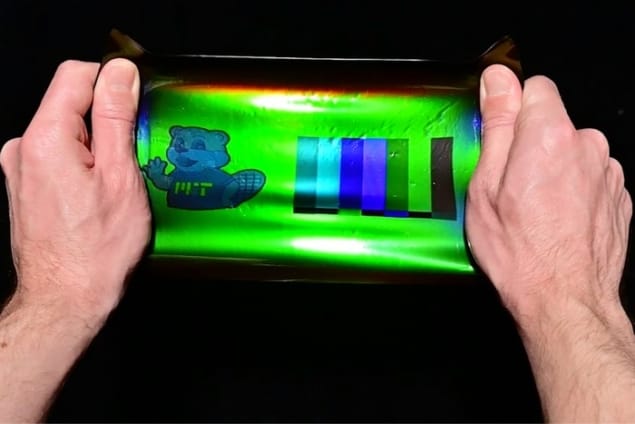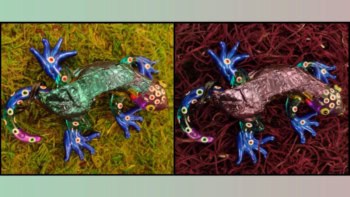
Building on a largely forgotten photography technique, researchers in the US have developed a photographic material that changes colour when stretched. Working at the Massachusetts Institute of Technology (MIT), the team showed how colour images can be created by modifying the nanoscale structure of the film. These structures reflect light at different wavelengths, which change as the film is stretched. The researchers say that their method offers a low-cost, scalable approach to creating new optical materials.
Structural colour is common in nature and familiar examples include the feathers of some birds and the wings of some butterflies. Instead of using pigments, structural colour is created by the interference of light that has been reflected from microscopically textured surfaces. The result is that certain colours are visible at certain viewing angles, while other colours are not. A related phenomenon called iridescence occurs when the structural colour of an object changes with the viewing angle.
Today, researchers are exploring how structural colour can be used in advanced optical materials. However, the appropriate nanoscale structures are often expensive and complex to produce, especially on large scales.
Nobel-winning technique
Now, MIT’s Benjamin Miller, Helen Liu and Mathias Kolle have developed a potential solution to this limitation. It is based on an early photographic technique that was first developed by the French physicist Gabriel Lippmann and which earned him the 1908 Nobel Prize for Physics. To capture images, Lippmann placed a thin, transparent emulsion of tiny, light-sensitive grains between two plates of glass. A mirror is positioned behind the back plate so that it reflects the light that passes through the emulsion.
When exposed to a visual scene, incident light waves entering the emulsion interfere with their reflections. This produces standing waves in the emulsion that gradually alter the nanoscale arrangements of the grains. This causes periodic variations in the film’s refractive index, capturing optical information from the visual scene. After up to several days of exposure, the arrangement of the grains is fixed, and the result is a colour image of the scene – an image that is much like a modern hologram.
However, Lippmann’s process was more time consuming and difficult than other colour photography techniques emerging at the time and has therefore been largely forgotten. Now, Kolle and colleagues have revisited the technique using modern holographic materials.
Light-sensitive polymer
The MIT trio began by placing a thin sheet of a stretchy, light-sensitive polymer against a mirror, and exposing it to a bright projected image. Just like with Lippmann’s approach, this created a pattern of standing waves, which altered the film’s refractive index. After just a few minutes of exposure, they then bonded the film to a silicone backing, creating large and detailed colour images.
Fast-switching structural colour could be used in low power video displays
As they stretched the film – by pulling on it or pressing objects into it – the nanostructures are distorted in a reversible way. This distortion alters the colour of the light reflected by the film (see figure). When the team made an all-red film, green images could be created by pressing objects onto the back of the film.
The team could also hide secret images in a film by capturing the image at a tilted angle of incidence. The resulting image is only visible in the near infrared – which cannot be seen by the human eye. However, when the material is stretched the image is shifted towards the red and becomes visible.
Kolle and team hope that their fast, scalable and affordable production technique could soon lead to practical optical materials that respond to mechanical stimuli. As well as encoding secret messages, other applications include clothing fabrics that change colour when they are stretched; and bandages that change colour as the pressure on a wound changes.
The research is described in Nature Materials.



